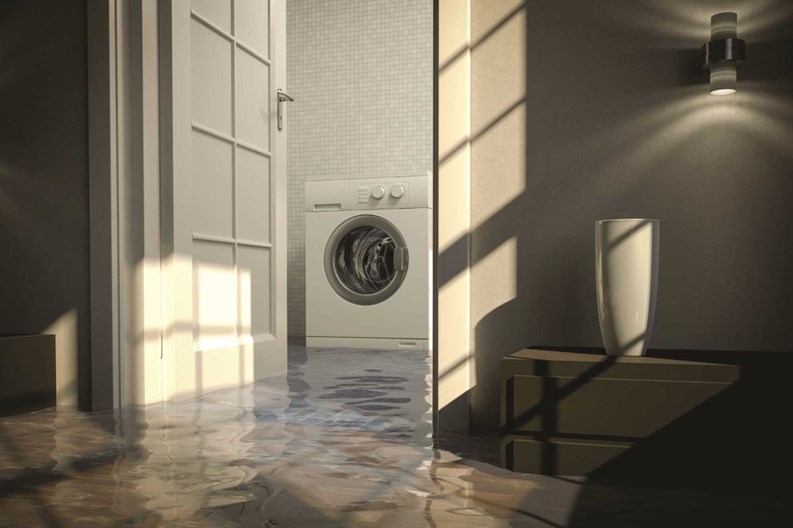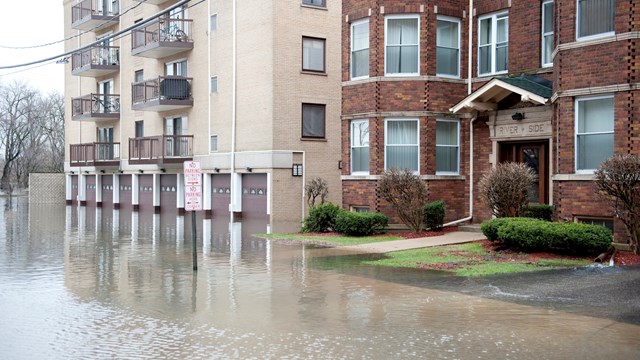When is a flood not a flood? That’s a serious question for Chicagoland’s residential communities. Even if they have flood insurance, damage caused by heavy rains and backed-up sewers may not meet the National Flood Insurance Program (NFIP) definition of a flood—and that can mean financial devastation for condo or co-op owners who thought they were fully covered.
“Flood insurance covers direct physical losses by flood and losses resulting from flood-related erosion caused by heavy or prolonged rain, coastal storm surge, snow melt, blocked storm -drainage systems, levee dam failure, or other similar causes. To be considered a flood, waters must cover at least two acres or affect two properties,” says Loretta Worters, vice president of the Insurance Information Institute (I.I.I), a non-profit trade association sponsored by the property-casualty insurance industry.
For a flood-insurance claim, “You have to prove that the water came from a river, and not from rain or the sewer system,” says Lori Pastore, vice president of the DeWitt Stern Group insurance agency in Chicago. “Chicagoland is more susceptible to sewer backup than actual flooding. Sewer backup is addressed under a homeowners, condo association or commercial policy.”
Most Notable Floods
Although heavy rains are to blame for most Chicagoland flooding, top honors among Chicago floods in modern times goes to the famous “underground flood” of April 13, 1992. A wall beneath the Chicago River collapsed letting water pour into a network of municipal utility tunnels and filling basements all over the downtown Loop with more than 250 million gallons of water.
Electricity was shut off in much of the Loop. Trading halted on the Chicago Board of Trade and Chicago Mercantile Exchange, with global repercussions. Water Mold and Fire, a restoration company serving the Chicago area, says the mishap cost close to $2 billion. That was bad enough, but in 1992, relatively few people lived in the Loop. Today, many former office buildings in the area have been converted to residential use, so if a similar disaster occurred now, the cost in terms of dollars and property would likely be far higher.
The city’s biggest record rain event took place on August 13th and 14th of 1987 when almost nine and a half inches fell on the city. Damages from this storm reached $220 million, and three fatalities were attributed to it.
Where Flooding Happens
Flooding in Chicagoland occurs primarily along the Des Plaines, Fox and Kankakee rivers and their tributaries and in the low-lying Calumet area straddling the Illinois-Indiana state line. Elsewhere, Pastore says, “Everybody is in a flood zone. It’s just a matter of what level of risk you’re at.”
Kelly Rumachik, an account executive at CISA Insurance in Elgin, explains that lenders typically require flood insurance in the special flood-hazard area zones: A, AE, AH, AO, A99 and AR. In zones B, C and X, the risk is considered low to moderate, so lenders typically don’t require flood coverage for them—unless the property being insured is directly adjacent to a high-risk zone.
Paradoxically, although Lake Michigan itself is a special flood-hazard area, most structures along the shoreline aren’t considered to be at high risk. “The majority of the Chicago area is in flood zone X,” Pastore says. “The flood hazard is minimal, but it’s still a flood zone and there is still a risk.”
“From a residential community’s perspective, you should look at its proximity to a river,” Rumachik says. “Also, if an association has a big lake or a pond, your level of risk depends on the mapping. Every association can purchase a flood policy. If you do it in a lower-risk area, it’s very inexpensive.”
To find out what zone your property is in, visit the Federal Emergency Management Agency (FEMA) Map Service Center at www.msc.fema.gov and type in your address. Be forewarned, however; the website is clunky and cumbersome, and getting your info may require some patience. Also, “Flood zones change all the time,” notes Scott McGinness, vice president of commercial sales at Gregory & Appel Insurance in Indianapolis, Indiana, whose company serves clients in the Chicago area, so you may want to recheck the site periodically.
Why NFIP?
After several disastrous Mississippi River floods led most private-sector insurance companies to abandon flood coverage, Congress created the NFIP in 1968. Today the NFIP is part of FEMA, which in turn is part of the Department of Homeland Security.
The NFIP provides insurance coverage to 5.5 million properties in flood-prone regions throughout the U.S. In an average year, the program is supposed to take in enough money to cover its flood claims, but major disasters—including Hurricane Katrina in 2005 and Superstorm Sandy in 2012—have left the NFIP $25 billion in debt to the U.S. Treasury.
Two years ago, Congress passed the Biggert-Waters Flood Insurance Reform Act of 2012 (BW-12), which would have increased premiums in four annual giant steps to reach an actuarially sound level. Single-family homes began to be affected in 2013. New maps going into effect in the next few years will place some residential communities into a special flood-hazard zone with a much higher premium.
When affected individuals and groups realized the impact that the BW-12-mandated premium increases would have, they complained to their congressional representatives. The lawmakers responded by enacting the Homeowner Flood Insurance Affordability Act of 2013, which President Barack Obama signed into law on March 24, 2014. By repealing the most onerous provisions of BW-12, the new law will slow the rise in premiums, giving property-owners more time to adjust while delaying the attainment of full actuarial soundness.
Condos, Co-ops and HOAs
If your condominium is in a special flood-hazard area, your board has a fiduciary obligation to buy flood insurance on the structure and also on the contents of the common areas such as offices, meeting rooms and game rooms. Elsewhere, it isn’t a bad idea. Twenty-five percent of all NFIP flood claims are for homes outside of high-risk zones, reports Worters.
In a co-op, a private cooperative corporation owns the buildings and land, while the stockholders have a proprietary lease on their living quarters. The cooperative's bylaws should specify the corporation’s responsibility to insure the building.
Condos and co-ops buy a Residential Condominium Building Association Policy (RCBAP). Individual condo owners and co-op stockholders may buy flood insurance for their own furniture, fixtures, equipment, and any additions or alterations they make at their own expense to the interior of their own condo or leased co-op unit.
Lenders may require individual owners on upper floors to buy flood insurance, but it shouldn’t cost very much. “The higher up they are, the less exposure they have, and the lower their premium should be,” McGinness says. After a flood, upper floors may remain habitable—unless the first and second floors wash away, causing the entire structure to tumble down. Even without such a collapse, plumbing and electrical equipment (panels and wiring) can be severely damaged, necessitating their replacement several floors above the level of the flood.
As premiums rise, some condo associations and co-op corporations may consider dropping flood insurance. “That’s very risky,” says Thomas A. Cook, Jr., a senior vice president at Brown & Brown Insurance, Inc. One of the world’s 10 largest insurance intermediaries, Brown & Brown operates in multiple U.S. states, including Illinois.
“If the condo owners or co-op stockholders win a lawsuit over a special assessment for uninsured flood damage, the directors, and officers, insurance probably won’t pay the judgment, which means the board members or corporate officers will be personally liable.”
Cook says a homeowners’ association typically would insure only its community’s common elements, such as a clubhouse, pool house, and equipment shed. The covenants or bylaws would stipulate an individual homeowner member’s responsibility for his own residence. If it’s a freestanding structure, a duplex, or a triplex, he would buy his own flood insurance. In a larger structure with a single policy, all the residents would divide the premium cost.
Limits and Excess
In a residential co-op with more than five units, the maximum amount of NFIP coverage available was $250,000 on the building and another $250,000 on the contents of the common areas. On June 1, 2014, those limits increased to $500,000. “That’s not likely to get them very far. Most need to look at purchasing excess coverage,” McGinness says.
Condos have their own set of rules. “The limit available from the NFIP is at least 80 percent of the full replacement cost, or $250,000 per unit, whichever is less,” McGinness says. Thus, a 10-unit condo could buy up to $2.5 million from NFIP.
Excess coverage is available from several private specialty carriers, including Lexington Insurance Company and Lloyds of London. “Some will offer it in Zone A with a $250,000 deductible, so you would buy the first layer from NFIP and the private insurer will pick up the excess,” Pastore says. She notes that NFIP doesn’t offer business-interruption insurance. “That might be a concern if you were a commercial condo owner in a mixed-use building with commercial units on the first and second floors. You would have to cover business interruption on a primary standard property-owner policy.”
If you’re not in Zone A, several private insurers might offer first-dollar flood coverage in competition with NFIP. Pastore says their rates can be competitive. Some private insurers even include flood coverage as an endorsement in an overall package designed especially for condo associations. “Ninety percent of associations who can buy standard do so,” she says. “For individuals who can buy standard, if the banks don’t require it or if they don’t have a mortgage, whether they buy it depends on who is selling their homeowners insurance.”
For residential communities and individual owners seeking alternatives to NFIP, Pastore suggests Admiral Insurance Company, the Chubb Group of Insurance Companies, CNA, Distinguished Programs Group, Great American Insurance Company, and Greater New York Insurance Companies, as well as Lexington and Lloyds.
George Leposky is a freelance writer and editor and is a frequent contributor to The Chicagoland Cooperator.







Leave a Comment